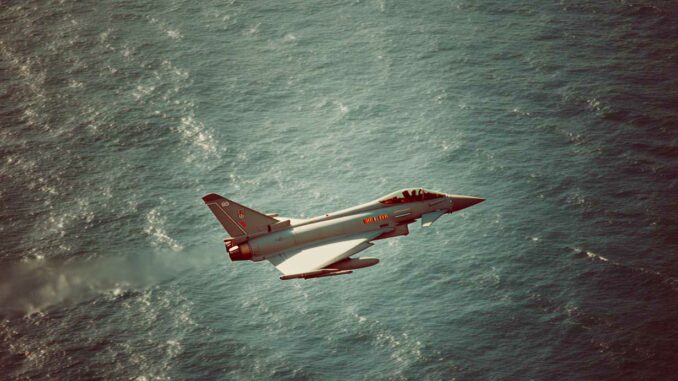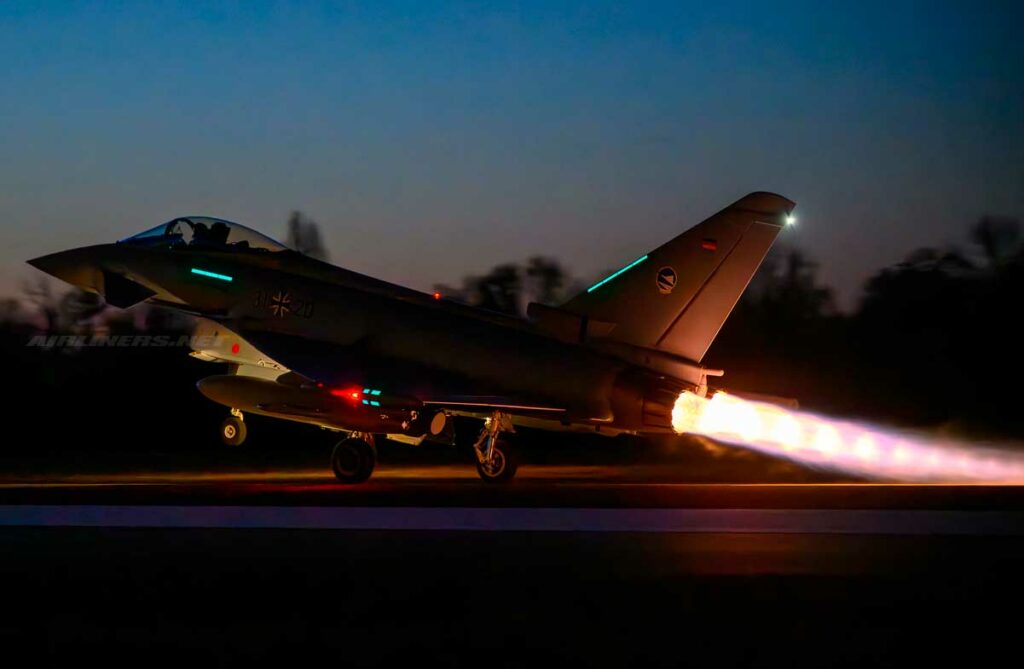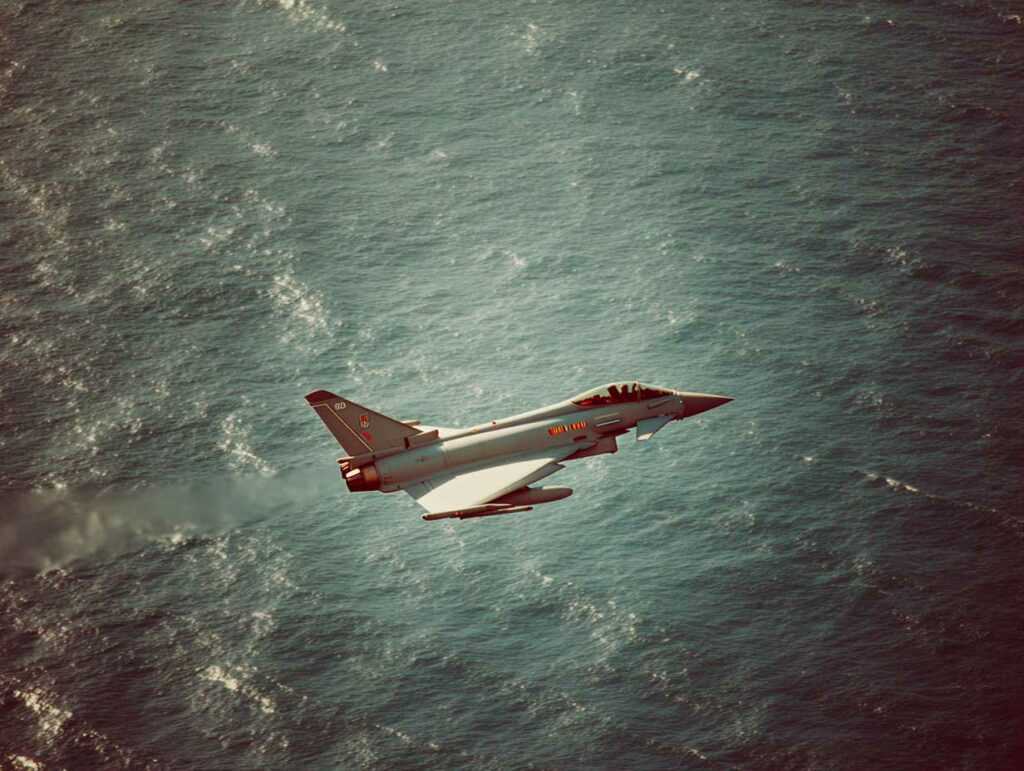
A German Eurofighter was reportedly targeted by a Chinese laser in the Red Sea amid growing tensions between naval powers.
On July 8, 2025, a German Eurofighter Typhoon fighter jet engaged in the European Aspides operation in the Red Sea was reportedly targeted by a Chinese laser system, according to a statement from the German Foreign Ministry. The incident occurred while the aircraft was patrolling a critical area off the coast of Yemen as part of a mission to secure shipping lanes threatened by Houthi attacks.
The beam was reportedly detected by the Eurofighter’s optical sensors, causing minor damage to some optronic equipment. No injuries were reported. Berlin accuses a Chinese Type 054A frigate in the area of intentionally directing the beam at the aircraft. Beijing has not acknowledged the incident, saying that its forces “act in accordance with international law.”
If confirmed, this incident would constitute a serious act of military harassment, revealing rising tensions between naval powers in this strategic region. It comes amid growing rivalry in the Red Sea, where China is expanding its naval presence under the guise of anti-piracy operations, but in areas increasingly close to European and US forces. The incident could accelerate the tightening of rules of engagement and reignite debates on non-lethal electronic warfare on the high seas.

A revealing incident in a congested maritime area
The Aspides mission and securing the Bab el-Mandeb Strait
Operation Aspides, launched in February 2024 by the European Union, aims to protect freedom of navigation in the Red Sea, in a strategic corridor linking the Mediterranean to the Indian Ocean via the Suez Canal. Since the start of the war in Gaza and the resurgence of Houthi strikes, numerous merchant ships have been targeted by drones, missiles, or drifting mines. More than 30 incidents were recorded between January and June 2025, according to the EUMS (European Union Military Staff).
In this context, Germany has deployed four Eurofighter Typhoons from Al-Azraq Air Base (Jordan), in addition to the frigate Hessen F221. These aircraft provide air cover, optical reconnaissance, and escorts for civilian ships. They have a range of nearly 1,400 kilometers and are equipped with Litening pods for infrared surveillance.
The incident on July 8 occurred during a routine flight near a convoy of three European oil tankers. The Eurofighter suffered a temporary optical disturbance, confirmed by post-flight analysis of the onboard sensors. The pilot immediately performed an evasive maneuver before returning to base. Initial data showed a laser beam directed from a stationary naval position within a 5-kilometer radius of the convoy.
Increased naval activity
The incident took place 80 kilometers southwest of Al-Hudaydah, in the midst of an asymmetric war zone. It is also the scene of a risky coexistence between several foreign naval forces: the US Task Force 153, Saudi vessels, the Aspides mission, and two Chinese Type 052D destroyers. The latter regularly escort Chinese-flagged cargo ships, officially to prevent acts of piracy.
The rules of engagement in this area remain unclear. There is no multinational mission coordinating movements between these groups, which encourages uncoordinated tactical incidents. Radar and optronic operators are therefore exposed to conflicting signals, increasing the risk of confusion and inappropriate responses.
China’s use of naval laser systems
A well-documented arsenal
The Chinese navy is equipping its Type 054A frigates and Type 052D destroyers with low-energy laser systems, originally designed to blind the optronic sensors of enemy drones, aircraft, and missiles. The most frequently cited model is the ZK-02, capable of projecting a short-range beam, without direct lethal intent but sufficient to damage an infrared sensor or CCD camera.
Back in 2018, Chinese forces were accused of illuminating a US P-8A Poseidon patrol aircraft in Djibouti. According to the US Navy, the beam caused a minor eye injury to the co-pilot. Since then, similar incidents have been reported sporadically in the Pacific, notably against Canadian and Australian aircraft. The July 8 incident is believed to be the first documented case in the Red Sea involving a European aircraft.
The tactical advantage of such a system is twofold: it leaves no radar or thermal signature and can cause temporary disruption to enemy sensors without crossing the threshold of the use of armed force as defined by international law. This allows pressure to be exerted without provoking an armed response, as long as the effect remains limited.
A strategy of controlled provocation?
The Chinese navy appears to be following a doctrine of non-lethal technological pressure, relying on targeted disruption rather than direct confrontation. The use of lasers, if confirmed, fits into this framework: intimidating, slowing down, signaling a no-approach zone, without opening fire. This type of behavior has been theorized by the Naval Strategy Center at Peking University as a “tactical threshold game.”
In this case, the laser was reportedly used as the Eurofighter approached within 3 kilometers of a convoy escorted by a Chinese frigate. The signal sent is clear: China claims de facto control over certain areas without formally designating them. This raises concerns on the European side, which considers these areas to be international transit routes.

A diplomatic and operational response is expected
An official protest from Berlin and an investigation underway
The German Foreign Ministry summoned the Chinese ambassador to Berlin, demanding an official explanation. The protest was not made public in its entirety, but a verbal note was reportedly sent. The Bundeswehr is conducting a technical investigation to determine the intensity of the beam, the exact nature of the sensors affected, and the risks involved.
The Eurofighter in question will remain grounded until a full inspection has been carried out. The estimated cost of the damage is less than $150,000, but the incident has a disproportionate political impact. It raises the question of the freedom of action of European forces in areas where China’s naval presence is becoming assertive and where interactions are increasingly tense.
Towards a change in European rules of engagement?
The incident could prompt EU member states to review the rules of engagement for the Aspides mission. Currently, pilots are not authorized to respond to laser illumination with active countermeasures, except in cases of lethal threat. A review is underway in Brussels, with proposals to allow reciprocal intimidation maneuvers, including targeted radar illumination or tactical jamming.
In addition, discussions are underway on the sharing of electronic warfare sensors within the mission to enable more accurate detection of laser emissions, including low-energy ones. The aim is to prevent covert attacks, which are now well documented, and to respond to them in a coordinated manner without escalation.
War Wings Daily is an independant magazine.